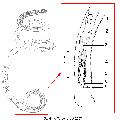Groupe : Reproductive tract of the female
The female reproductive tract consist of two branches, usually opposed (amphidelphic), each composed of an ovary, oviduct, and uterus. The two branches unite at an ovejector which empties into the vulva in the midbody region.The ovejector functions in copulation and egg laying and is composed of paired infundibula and sphincters, and acommon vestibule and vagina vera.
During the course of evolution, Trichostrongylina tend to become smaller: the size of the eggs diminishes and the number of the eggs per female increases. The uteri take up an increasingly greater proportion of the animal and there is a tendency to pass from the didelphic condition to monodelphy , i.e., a reproductive system consisting of a single branch composed of an ovary, oviduct and uterus, and half an ovejector. Monodelphy presumably permits more efficient use of space. In the vast majority of cases it is the posterior branch of the reproductive system with atrophies and this is accompanied by migration of the vulva to the anal region.
In Heligmonellinae, the females are always monodelphic, i.e. their reproductive apparatus present only one anterior branch.
